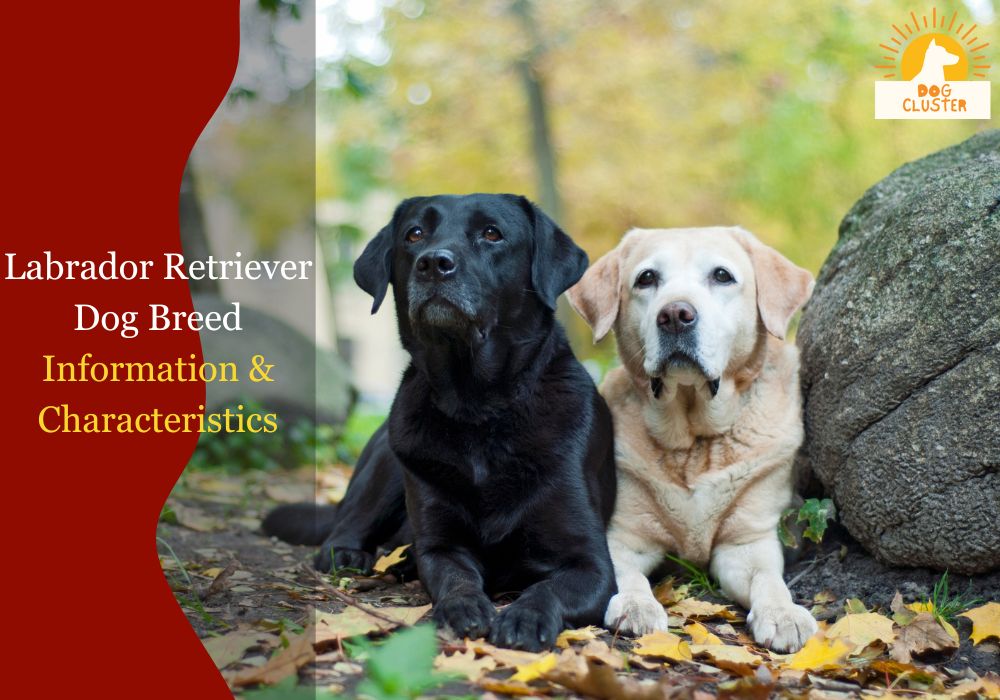The Labrador Retriever is a popular dog breed known for its friendly and outgoing personality, as well as its versatility in various roles.
This article aims to provide comprehensive information about the Labrador Retriever, covering its origin, physical characteristics, grooming, health concerns, training, and considerations before getting this beloved breed.
Table of Contents
What is a Labrador Retriever?

The Labrador Retriever, often referred to as “Lab,” originated in the Newfoundland region and was initially bred as a working dog, assisting fishermen in retrieving nets and fish from the cold waters. The breed’s history dates back to the early 19th century, with the Earl of Malmesbury being among the first to recognize and develop the breed’s potential as a reliable retriever. Their exceptional retrieving abilities and amiable nature led to their recognition as a distinct breed by the American Kennel Club (AKC) and their widespread popularity in the United States and worldwide.
Labrador Retrievers are well-built, medium to large-sized dogs with a sturdy and athletic physique. They have a short, dense coat that comes in three standard colors: black, yellow, and chocolate. Their expressive eyes and otter-like tail are among the defining physical characteristics of the breed, exuding a friendly and intelligent demeanor that is inherent to Labs.
Known for their intelligence, friendly disposition, and adaptability, Labrador Retrievers make excellent family pets, service dogs, therapy dogs, and even excel in dog sports. Their gentle temperament and eagerness to please make them highly trainable and well-suited for a variety of roles, including search and rescue, guide, and assistance work.
How to Groom a Labrador Retriever?
Grooming a Labrador Retriever is relatively straightforward, requiring regular brushing to maintain their coat’s health and luster. A few essential grooming tools for Labs include a slicker brush, grooming mitt, shedding blade, and nail clippers. Regular brushing helps in removing loose and dead hair, especially during shedding season, which occurs twice a year.
Caring for the Labrador Retriever’s coat and undercoat is essential to prevent matting and maintain the natural waterproofing properties of their fur. Bathing should be done periodically using a mild dog shampoo to keep their coat clean and free of dirt and debris. Additionally, attention should be given to ear cleaning, dental care, and nail trimming to ensure the overall well-being of your Labrador Retriever.
Labrador Retrievers are known for their active lifestyle and predisposition to outdoor activities. Therefore, maintaining proper hygiene, including regular grooming, is vital to keep your Lab healthy and comfortable.
What are the Health Concerns for Labrador Retrievers?

Like all breeds, Labrador Retrievers are prone to certain health issues that owners should be aware of. Common health concerns in Labs include obesity, joint problems, and certain genetic conditions such as hip and elbow dysplasia. These orthopedic issues can be managed through a balanced diet, regular exercise, and weight management to alleviate stress on their joints.
Understanding the risk of hip and elbow dysplasia in Labs is crucial for proactive care. These conditions, characterized by abnormal development of the hip or elbow joint, can lead to discomfort and mobility issues. Pet parents should work closely with their veterinarian to monitor and address any signs of joint problems and embrace preventive measures to support their Lab’s joint health.
In addition to joint health, maintaining a proper diet and exercise routine is essential for the overall well-being of Labrador Retrievers. Providing a well-balanced diet, regular veterinary check-ups, and ample opportunities for physical activity contribute to the longevity and vitality of the breed.
Training and Temperament of Labrador Retrievers
Training a Labrador Retriever is a rewarding experience, given their intelligence, eagerness to learn, and natural retrieving instincts. Positive reinforcement methods, obedience training, and consistency are fundamental for shaping their behavior and ensuring they become well-mannered and obedient companions.
The eager-to-please nature of Labrador Retrievers makes them responsive to training, whether it’s basic obedience, advanced skills, or participating in dog sports such as agility and flyball. Their innate drive to work and please their owners has made Labs successful in various competitive events, showcasing their versatility and dedication to training.
Understanding the energy and exercise requirements of Labs is crucial for their physical and mental well-being. Regular exercise, including long walks, playing fetch, and engaging in interactive activities, helps to channel their energy and prevent behavioral issues stemming from boredom or lack of stimulation. Incorporating mental stimulation and physical activity into their routine contributes to a well-balanced and contented Labrador Retriever.
Considerations before Getting a Labrador Retriever

Before welcoming a Labrador Retriever into your home, it’s important to assess whether this breed aligns with your lifestyle and preferences. Labrador Retrievers are known for their friendly and sociable nature, making them excellent family dogs. However, their energetic disposition and need for regular exercise and mental stimulation should be considered when evaluating their suitability for your home environment.
Preparing your home for a Labrador Retriever involves creating a safe and comfortable space for their physical and emotional well-being. This includes providing them with a cozy bed, interactive toys, suitable feeding and water stations, and secure fencing to ensure their safety and prevent wandering. Additionally, creating a consistent routine and setting clear boundaries through positive reinforcement lays a strong foundation for a harmonious relationship with your Lab.
When seeking a Labrador Retriever, it is crucial to find reputable breeders or consider rescue groups that specialize in the breed. Reputable breeders adhere to responsible breeding practices, promoting the health and welfare of their dogs and producing well-socialized puppies with sound temperaments. Conversely, rescue groups provide an opportunity to offer a loving home to a Labrador Retriever in need, contributing to the welfare of the breed and embracing the rewarding experience of rescuing a dog in search of a forever home.
FAQ
What are the characteristics of the Labrador Retriever breed?
Labrador Retrievers are known for their friendly and outgoing nature. They are also highly intelligent, energetic, and good-natured, making them excellent family pets.
Are Labradors a popular dog breed?
Yes, Labrador Retrievers are one of the most popular dog breeds in the United States. They are known for their loyalty, intelligence, and gentle temperament, which contributes to their popularity as family pets.
How should I groom a Labrador Retriever?
Labrador Retrievers have a short, water-resistant coat that requires regular brushing to minimize shedding. They should also be bathed occasionally, and their nails should be trimmed to maintain overall grooming.
What health issues are common in Labrador Retrievers?
Some common health concerns for Labrador Retrievers include hip dysplasia, exercise-induced collapse, and progressive retinal atrophy. Regular veterinary check-ups and a balanced diet can help manage these potential health issues.
Are Labradors easy to train?
Yes, Labrador Retrievers are known for their intelligence and eagerness to please, which makes them relatively easy to train. Positive reinforcement methods and consistency are key to successful training.
What type of exercise does a Labrador Retriever need?
Labradors are energetic and active dogs that require regular exercise. They enjoy activities such as walking, running, swimming, and playing. Engaging them in physical and mental activities will help keep them happy and healthy.
Are Labrador Retrievers suitable for families with children?
Yes, Labrador Retrievers are generally friendly and tolerant, making them great companions for families with children. With proper training and socialization, they can be gentle and protective around young family members.
How do I train a Labrador Retriever for specific tasks, such as hunting or assistance work?
Training a Labrador Retriever for specific tasks involves using positive reinforcement techniques and consistent practice. For hunting, seek specialized training methods, while for assistance work, consider professional guidance and tailored training programs.
What are the key considerations when adopting a Labrador Retriever?
When adopting a Labrador Retriever, consider their exercise needs, grooming requirements, and potential health issues. It’s essential to provide them with a loving and active lifestyle, regular veterinary care, and appropriate training and socialization.
Can a Labrador Retriever adapt to different living environments?
Labrador Retrievers are adaptable and can thrive in various living environments, including apartments, as long as they receive adequate exercise and mental stimulation. Providing them with a balanced routine and environment will help them adjust to different living spaces.





Leave a Reply